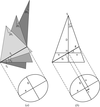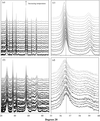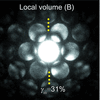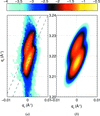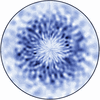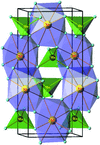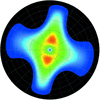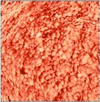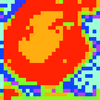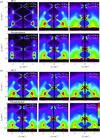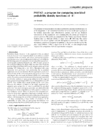issue contents
October 2013 issue

Cover illustration: A schematic of a new X-ray scattering geometry, grazing-incidence transmission small-angle X-ray scattering. The incident beam impinges on the edge of a nanostructured surface at a grazing angle, and exits through the sample's edge. The method is demonstrated for gratings where it is shown that the Born approximation is valid with a simple and small correction. Courtesy of Lu et al. [J. Appl. Cryst. (2013), 46, 165-172].
research papers
Open  access
access
 access
accessA complete method for calibrating a two-dimensional flat-panel detector for use in X-ray diffraction is described. The method provides both the beam energy and the sample-to-detector distance. The geometry for the intersection of a cone's axis and its elliptical conic section is also presented.
Open  access
access
 access
accessUsing the spacing and position of X-ray interference fringes accompanied by mirage diffraction, the strain distribution of a plane-parallel Si single crystal fixed at one end has been measured as a function of the distance l from the incident plane of the X-rays to the crystal edge. The measured strain gradients are proportional to l2, which agrees with rod theory.
X-ray residual stress analysis on multilayer systems: an approach for depth-resolved data evaluation
An evaluation concept for the analysis of the residual stress state in individual layers of a multilayer system is presented.
As new figures of merit to compensate for disadvantages of the de Wolff figure of merit, the reversed figure of merit and symmetric figure of merit are introduced.
The thermal expansion behaviour of manganese dioxide, an important battery material, is reported using high-temperature in situ X-ray diffraction between 298 and 673 K.
Round-robin measurements of polystyrene latex samples at a number of small-angle scattering facilities have been used to assess the current limits of reliability and reproducibility of scattering data, as well as the accuracy of parameters derived from subsequent analysis such as the radius and polydispersity. These results are used to develop understanding and improve the technique.
Theoretical models are developed for the variation of the rocking curve peak positions of a single-crystal wafer as a function of the azimuthal angle. Using these models, a measurement method for the surface orientation of a wafer with a small surface miscut of <∼3° is proposed and the orientation is measured for a sapphire wafer.
Charge flipping is shown to be as efficient as direct methods for routinely solving small-molecule structures. Two enhancements of charge flipping are compared with the usual variant.
An empirical relation was found to estimate the average number of platelets per tactoid as follows: 〈N〉 = δ + α〈D〉, where δ is a constant and α the slope.
In order to determine the residual stress state of thin diamond coatings that are deposited on WC–Co substrates, an approach to separating the overlapping reflections of diamond and cobalt, based on grazing diffraction conditions, is presented. For verification of the experimental results, complementary Raman spectroscopy measurements were performed.
New developments in convergent beam electron diffraction analysis give direct evidence for locally varying symmetry fluctuations at the nanoscale for Pb(Mg1/3Nb2/3)O3–PbTiO3, and energy dispersive X-ray spectroscopy results show associated variations in chemical composition, leading to fluctuations in ionic displacements and spontaneous polarization for the complex relaxor ferroelectric.
The detailed resolution kernel for a double-chopper time-of-flight neutron reflectometer is calculated in terms of probability density functions. A comparison is made between the resolution kernel and the Gaussian approximation formed by adding the variance of the individual wavelength and angular components.
A design for a continuous-source wide-bandwidth energy-dispersive neutron powder diffractometer is proposed. The high incident neutron flux and highly parallel detection system offer a greatly enhanced data collection rate while maintaining sufficient resolution for structural studies.
A structure–function investigation, using anomalous small-angle X-ray scattering and UV–Vis spectroscopy, leads directly to a mechanistic proposal of cascade catalysis of Au/Pd nanoparticles.
Neutron focusing effects were investigated for a very small angle neutron scattering instrument. The out-of-focus condition was examined using resolution measurements, analytical calculations and ray tracing simulations. Reasonable agreement was found.
A diffractometer setup based on a laser-driven plasma X-ray source for reciprocal-space mapping with femtosecond temporal resolution is presented, including a detailed characterization of its resolution function. For crystalline samples with insignificant in-plane Bragg peak broadening, a correction method is derived in order to achieve high-resolution rocking curves with improved data quality.
Open  access
access
 access
accessResidual stresses in as-deposited and blasted TiN coatings are characterized using a Laplace approach and using the novel cross-sectional X-ray nanodiffraction technique. A comparison of real and Laplace space techniques demonstrates the advantages of the nanodiffraction method, with a possibility to analyse local gradients of stress, texture, crystallite size and phase in thin films and coatings.
Neutron and X-ray reflectivity, as well as small-angle scattering, are used to probe the in-plane and surface-normal structure of anodized aluminium. A new low-voltage anodization protocol gives smooth anodic films on aluminium, suitable for investigation by neutron and X-ray reflectivity.
A study of multiple twins in commercial pure titanium evidenced the influence of twinning order on the multiple twin variant, the role of the normalized Schmid factor in the twin variant selection, and the critical condition of twinning being activated by another twin in a neighbouring grain.
Internal structures of polymer micelles of poly(4-vinylphenol)-block-poly(4-bromostyrene) in alkaline solution are characterized using anomalous small-angle X-ray scattering near the Br and Rb K edges.
It is shown that the Dauphiné twin is very abundant but the other twin laws (Japan, Esterel, Sardinian, Breithaupt and Cornish) are very rare for the quartz in the granite of Tiantangzhai pluton (China). Besides twin laws, many intergrowths based on overlapping faces are found, and these faces are simply the twin planes of the Japan, Esterel, Sardinian, Breithaupt and Cornish twin laws.
Three-dimensional reciprocal space mapping is found to be a powerful and crucial method for the analysis of diffuse scattering originating from stacking faults that are diffracting in a noncoplanar geometry. The technique could be used to confirm transmission electron microscopy visibility criteria and to distinguish the origins of diffuse scattering signals.
Download citation


Download citation


Crystals of barium strontium molybdate, (Ba1−xSrx)MoO4, with x = 0, 0.25, 0.50, 0.75 and 1, have been synthesized by the co-precipitation (drop-by-drop) method. With increasing x, it is found that the crystal shape is modified and the crystal size, optical band gap and photoluminescence decrease.
The indirect Fourier transformation technique is extended to two-dimensional small-angle scattering patterns of oriented samples.
Almost spherical CaCO3 microparticles were obtained with poly(p-hydroxystyrene–b–methacrylic acid) (PHOS-b-PMAA), tuning the CaCO3 nuclei growth conditions via the inorganic and polymer concentrations. The synergetic action of the CaCO3 intrinsic characteristics and the enhanced pH sensitivity of the new composites make them potential drug release systems.
A nonnegative blind source separation technique, known as nonnegative matrix factorization, is applied to microdiffraction data to extract characteristic patterns and to determine their spatial distribution in tissue typing problems occurring in bone-tissue engineering.
It is proposed to use a compound refractive lens as a Fourier transformer to study structured single-crystal materials by means of high-resolution X-ray diffractometry. Fourier patterns recorded at different angles along the rocking curve provide detailed information on the intrinsic structure of the object.
Open  access
access
 access
accessA wide-angle X-ray fibre diffraction method is presented, which allows quantification of collagen orientation across large tissue areas. Application to the human eyeball coat (cornea and sclera) has yielded detailed maps of preferred fibril orientation and isotropic collagen distribution.
A strong influence of matrix type on self-assembled growth of three-dimensional Ge quantum dot lattices in amorphous oxide matrices is demonstrated. An interplay between quantum-dot-related surface features and smoothing tendency of the matrix determines the type and quality of Ge quantum dot ordering.
cryocrystallography papers
A new method is presented to reduce background scatter by use of graphene-based mounting of protein crystals.
short communications
A high-energy small-angle X-ray scattering (SAXS) facility has been implemented and integrated as part of an ultra-small-angle X-ray scattering (USAXS) suite; the instrument is described.
computer programs
A code to investigate noncovalent interactions making use only of the electron density distribution (theoretically or experimentally derived) is presented.
Open  access
access
 access
accessTwo software plugins are presented for the Mac OSX operating system that allow rapid and convenient visualization of Protein Data Bank files and X-ray diffraction images directly within the file browser, without the need for full-featured applications.
A computer program for ideal and non-ideal probability density functions of the magnitude of the normalized structure factor is described in detail. The program and related files are deposited as supplementary material.
laboratory notes
Temperature gradients within a plug flow microreactor were minimized by means of an aluminium shield. A further improvement was made via focusing the infrared radiation onto the catalyst bed. The result was an overall improvement in the efficiency of the reactor at high temperatures.
addenda and errata
Open  access
access
 access
accessErrors in the paper by Kanaki, Jackson, Hall-Wilton, Piscitelli, Kirstein & Andersen [J. Appl. Cryst. (2013), 46, 1031–1037] are corrected.
crystallographers
Free 



 journal menu
journal menu








